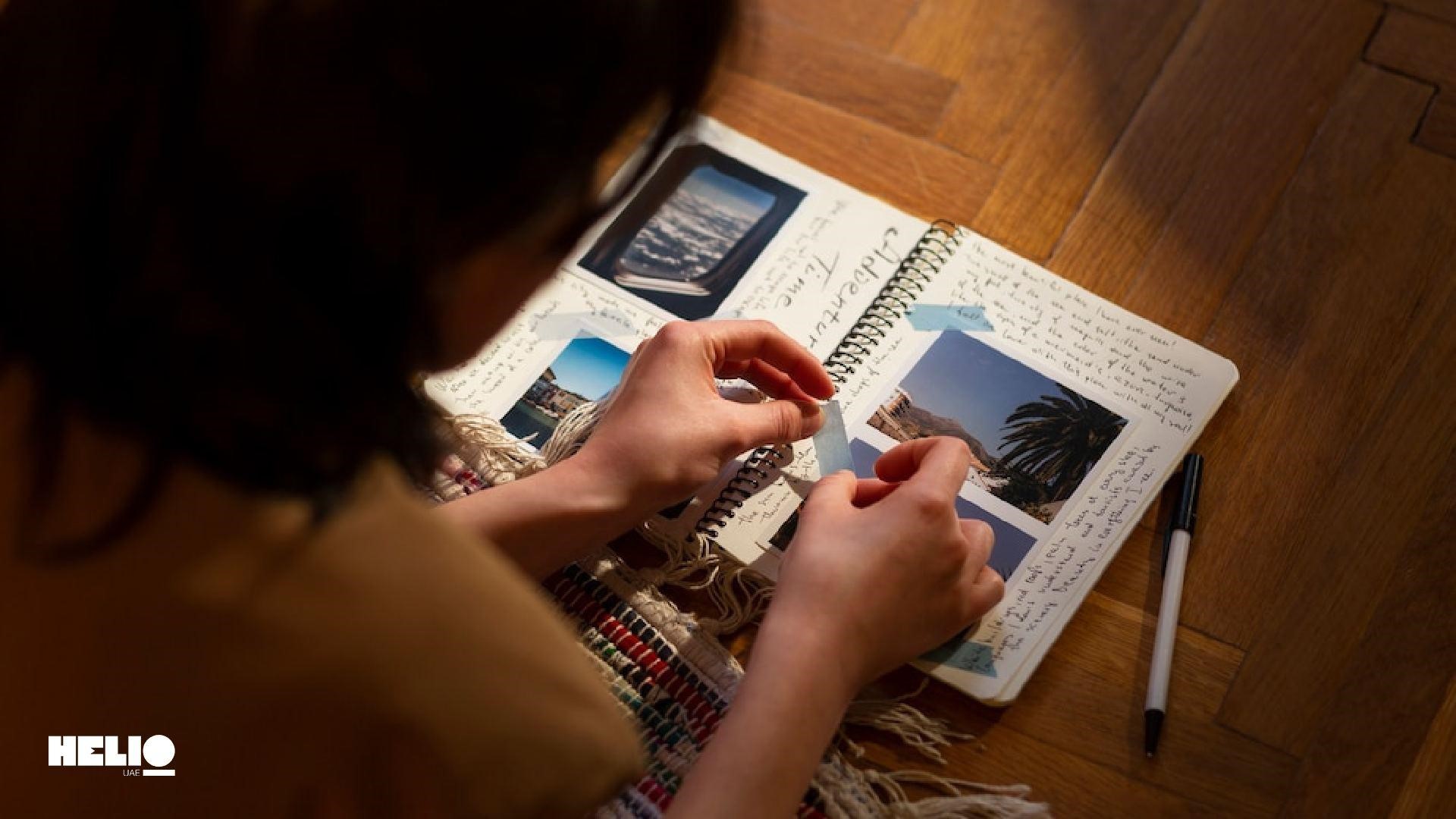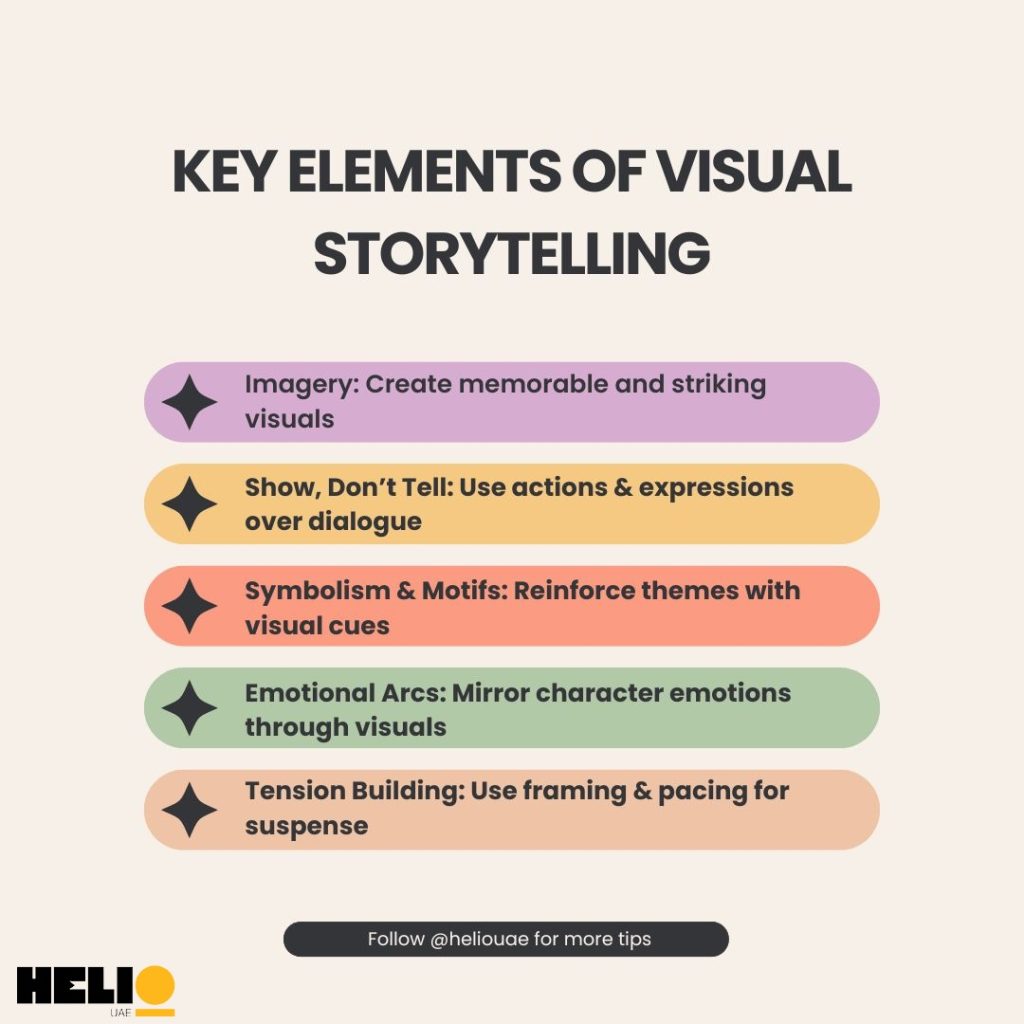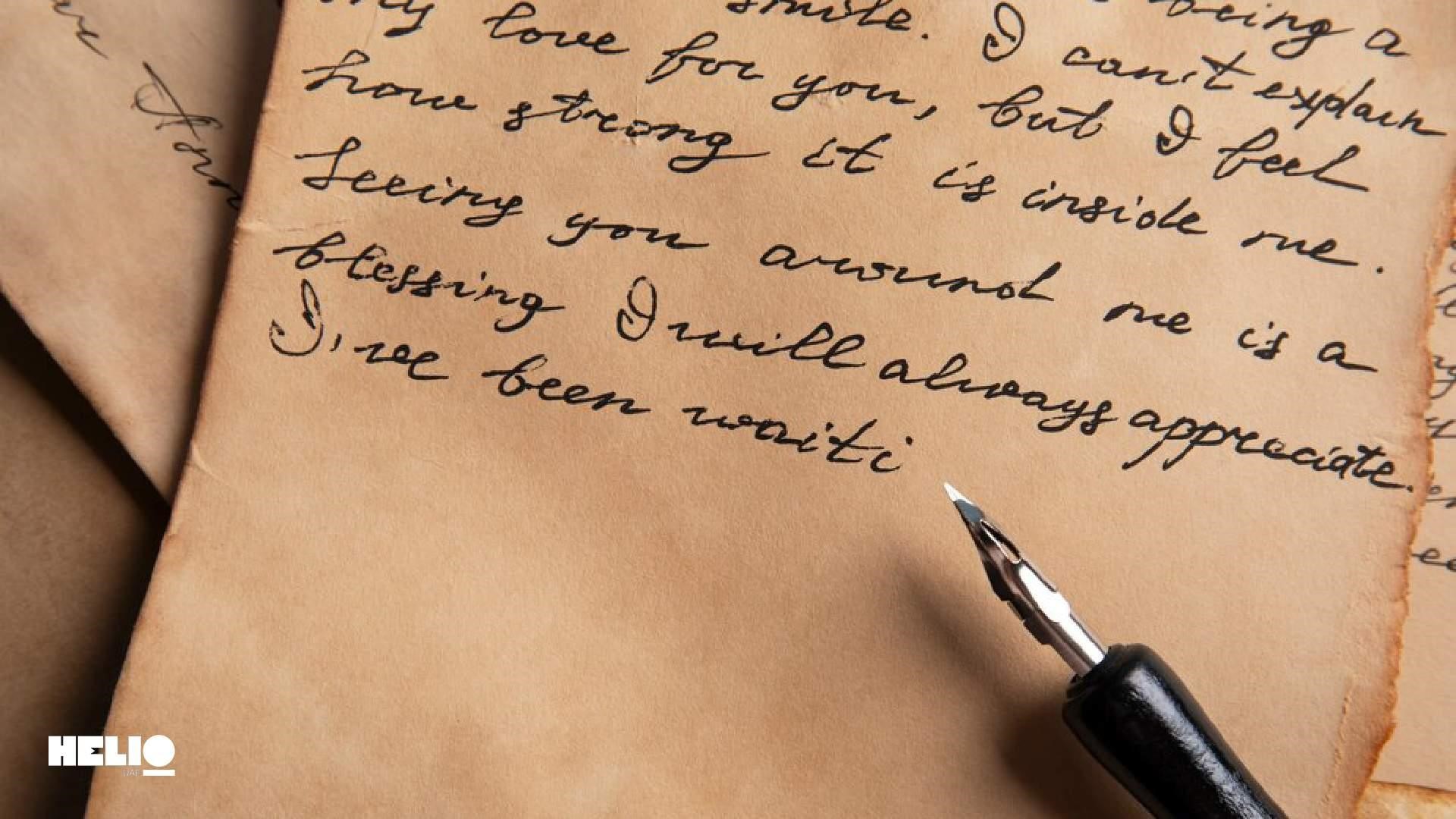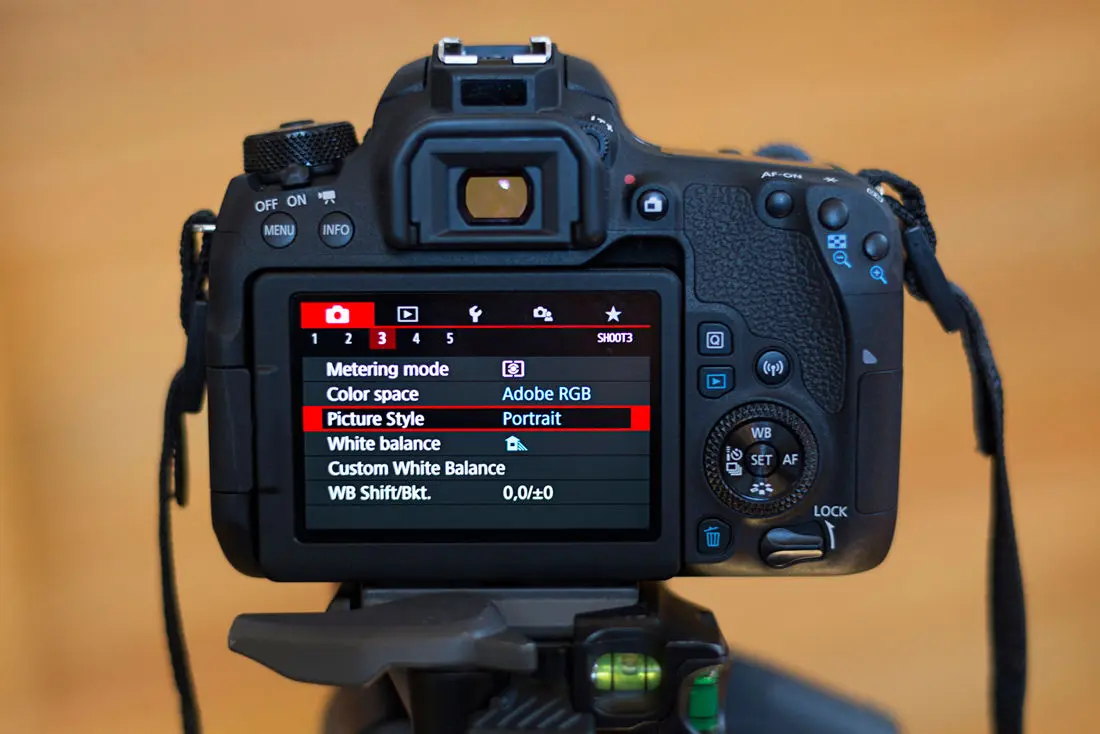Liten to this blog post:
There’s an art form in filmmaking and content creation that silently captures audiences, weaving narratives that speak beyond words—this is visual storytelling. It’s a technique that transforms scripts into vivid imagery, offering filmmakers and storytellers an evocative way to engage with their audience. But how can you improve this technique? What are scriptwriting techniques for visual storytelling? In this guide offered by Helio marketing company, we’ll explore scriptwriting techniques for visual storytelling. We will provide insights and tips that filmmakers in the UAE and beyond can leverage to elevate their craft.
What Is Visual Storytelling?
Visual storytelling is the art of conveying a narrative without relying heavily on dialogue. It communicates the story using visual elements such as composition, color, lighting, and camera movement. This technique is essential because it transcends language barriers and taps into universal human experiences, making it a powerful tool for filmmakers and storytellers worldwide.
The Importance of Script Writing in Visual Storytelling
Scriptwriting is the backbone of any film or video project. In visual storytelling, the script serves as the blueprint for the visual elements unfolding on screen. A well-crafted script ensures that every scene and frame serves a purpose in advancing the story. It’s not just about writing dialogue but defining visuals that express emotions and plot points. Writers must think about how each scene will look and feel, providing detailed descriptions that guide directors and cinematographers in bringing the script to life.
In video marketing, this approach becomes even more critical. The ability to tell a compelling story visually can mean the difference between a campaign that resonates deeply with audiences and one that fails to leave an impact. For businesses and creators aiming to connect with their audiences, mastering visual storytelling is a powerful tool.
If you need any help for your script writing in visual storytelling in the UAE, a creative video production company dubai , like Helio, could be an option.
| Aspect | Description |
|---|---|
| What is Visual Storytelling? | A technique that conveys narratives primarily through imagery, composition, lighting, and movement, rather than relying heavily on dialogue. |
| Importance of Scriptwriting | Defines visuals that express emotions and plot points, ensuring each scene advances the story effectively. |
| How It Works in Screenplays | Uses cinematic techniques, visual motifs, and symbols to add depth and layers of meaning. |
| Scriptwriting Techniques | Use vivid imagery Show, don’t tell Incorporate visual motifs Build tension with framing & pacing Use subtext through actions |
| Memorable Examples | Titanic – Visuals of grandeur & tragedy Wall-E – Storytelling with minimal dialogue Psycho – Tension through camera angles & editing |
| How to Improve Visual Storytelling | Work with expert video production companies, focus on cinematic language, and refine scripts to enhance visual depth. |
How Does Visual Storytelling Work In Screenplays?
In screenplays, visual storytelling involves crafting scenes that show rather than tell. It requires a keen understanding of cinematic techniques and how they can be used to elicit emotions and convey themes. Effective visual storytelling in screenplays often involves strategically using symbols, motifs, and visual metaphors that add layers of meaning to the narrative. For example, recurring visual cues to signify a character’s internal struggle or a pivotal plot development can make the screenplay more dynamic and engaging.
Creative concept development in video production plays a significant role in shaping these visual elements, ensuring that every detail aligns with the story’s core message and emotional tone.
How Do You Write Visual Storytelling?
Writing visual storytelling involves a blend of creativity, technical skill, and a deep understanding of cinematic language. It requires a writer to think visually and consider how each scene will unfold on screen. Here’s a breakdown of how to approach writing for visual storytelling:
- Visualizing Scenes: Start by envisioning how each scene will look. Consider the setting, the character’s actions, and the mood you want to convey. Use descriptive language to paint a picture of these elements in your script.
- Show, Don’t Tell: Focus on showing the story through actions, expressions, and visual elements rather than relying on exposition. This approach engages the audience more deeply, allowing them to infer meanings and emotions from the visuals.
- Use of Visual Motifs: Incorporate visual motifs or symbols that can recur throughout the story, adding depth and reinforcing themes. These can be objects, colors, or lighting that carry symbolic weight and enrich the narrative.

Scriptwriting Techniques for Visual Storytelling
Effective visual storytelling requires a set of techniques that can turn a script into a visually captivating experience. Here are some essential tips for visual storytelling in scriptwriting:
1. The Power of Imagery
Imagery plays a crucial role in visual storytelling. When writing a script, consider the imagery defining your film. What visual elements will stand out and stay with the audience? Use vivid descriptions to craft these images, ensuring they are integral to your story.
2. Crafting Emotional Arcs
The emotional arc of a story is often conveyed through visual elements. Consider how camera angles, lighting, and color can reflect a character’s emotional state or the tone of a scene. Write scenes that allow these visual elements to express the emotional journeys of your characters naturally.
3. Building Tension with Visual Cues
Tension is a key storytelling component, and visual cues can effectively build suspense. Use pacing, framing, and perspective shifts to keep the audience on edge. Describe how these elements should play out in your script to maximize dramatic impact.

4. Creating Subtext through Actions
Subtext is the underlying meaning beneath the dialogue. In visual storytelling, subtext can be conveyed through character actions and interactions. When writing, think about what your characters’ actions say about their motivations and relationships and how these can be depicted visually.
5. Enhancing Themes with Symbolism
Symbols are powerful in visual storytelling, offering a way to reinforce themes without overt explanation. Identify symbols that resonate with your story’s themes and weave them into your script. Describe how these symbols appear visually, adding meaning to your narrative.
Why Is Visual Storytelling So Important? Some Memorable Examples
Visual storytelling has a profound impact on how stories are received and remembered. Here are some standout examples from film history that illustrate its power:

Titanic
James Cameron’s “Titanic” is a masterclass in visual storytelling. The film uses sweeping visuals to convey the grandeur and tragedy of the doomed ship, while intimate moments between characters are depicted with detailed visual nuances. The iconic image of the ship sinking is not just a spectacle but a visual metaphor for love and loss.
Wall-E
Pixar’s “Wall-E” showcases how visual storytelling can thrive with minimal dialogue. The film uses expressive animation and visual details to convey character development and plot. The carefully crafted visuals beautifully portray Wall-E’s solitary existence and longing for connection.
Psycho
Alfred Hitchcock’s “Psycho” is renowned for its visual storytelling, particularly in the famous shower scene. Through meticulous editing, camera angles, and sound design, Hitchcock creates tension and horror that resonate beyond the screen. The film’s visuals convey psychological depth and thematic complexity, making it a timeless classic.
How to select a video production company in Dubai ? start by evaluating their portfolio, client reviews, and industry experience to ensure they meet your project needs.

The Best Visual Storytelling Scriptwriting with Helio
For filmmakers and content creators looking to elevate their visual storytelling, working with the top video production companies in Dubai can be a game-changer. These companies provide the expertise and resources needed to refine scriptwriting and enhance the visual impact of your narrative. Helio Commercial Video Production Company, for instance, offers a comprehensive platform to help filmmakers craft compelling visual stories that captivate audiences. Contact us for personalized advice.
By integrating visual storytelling techniques into your scriptwriting process, you can create stories that resonate more deeply. Helio provides the guidance and expertise to help you achieve this, making it an invaluable resource for anyone looking to master the art of visual storytelling. For more information, visit About Us.
Helio is a professional advertising company that offers various services, including:
- Helio digital marketing firm
- helio graphic design studio
- helio architecture company
FAQs
1. What is Visual Storytelling?
Visual storytelling is the technique of conveying a narrative using visual elements without heavy reliance on dialogue. It uses imagery, symbols, and cinematic techniques to create an engaging and emotionally resonant story.
2. How Does Visual Storytelling Work In Screenplays?
In screenplays, visual storytelling works by crafting scenes that prioritize showing over telling. Writers use detailed descriptions to guide directors and cinematographers in creating visual sequences that convey emotions and plot developments.
3. Why Is Visual Storytelling So Important?
Visual storytelling is essential because it engages audiences on a sensory level, transcending language barriers and tapping into universal human experiences. It makes stories more accessible and memorable.
4. How To Approach Visual Storytelling?
To approach visual storytelling, focus on visualizing scenes, incorporating symbols, and using imagery to convey emotions and themes. Practice crafting scripts that allow visual elements to drive the narrative.
In conclusion, mastering scriptwriting techniques for visual storytelling is a valuable skill for filmmakers and storytellers. By focusing on visual elements and using platforms like Helio, you can create compelling narratives that captivate and resonate with audiences. Whether you’re a seasoned filmmaker or a budding content creator, these techniques offer a pathway to tell stories that are as visually stunning as they are emotionally impactful.





